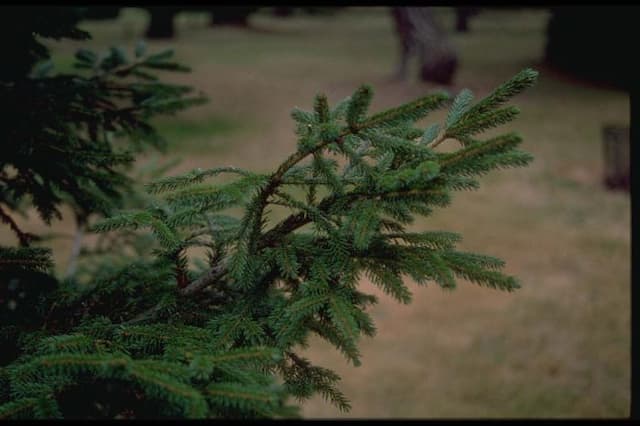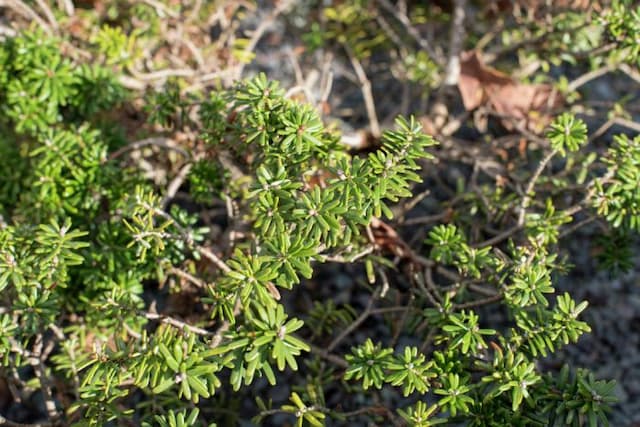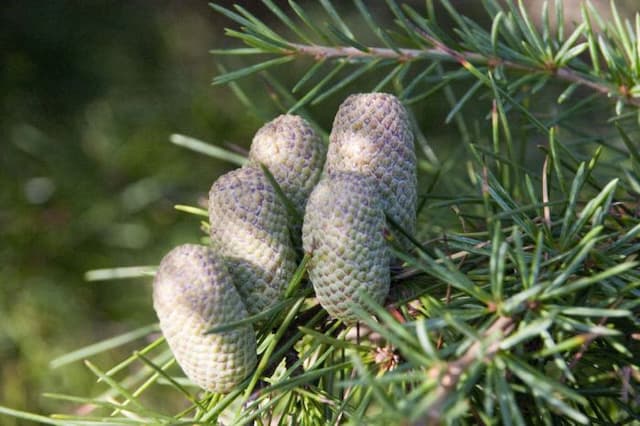Grand Fir Abies grandis

ABOUT
The plant known as "grand fir" has a distinctive and stately appearance featuring a conical shape typical of many evergreen trees. The bark on these trees is usually gray and furrowed, providing a textured look. The needles of the grand fir are particularly noteworthy; they are flat and glossy, displaying a lush dark green color on the top side and with two distinctive white lines on the bottom. When observed up close, the needles splay out in two distinct rows on either side of the twig, rendering a feathery and full appearance to the branches. During the growing season, the grand fir produces cones, which add to its ornamental value. These cones are initially green but mature to a purplish-brown shade, standing erect on the branches. They stand out against the foliage, providing visual interest and color contrast. Additionally, when the needles are crushed, they give off a pleasant citrus-like fragrance, which is a delightful characteristic of this plant and enhances its sensory appeal. The overall dense foliage and the symmetrical shape make the grand fir a striking plant that has a commanding presence in its natural setting. Its evergreen nature means it retains its color and vibrance throughout the year, making it a constant in the landscape regardless of the season.
About this plant
 Names
NamesFamily
Pinaceae.
Synonyms
Grand Fir, Giant Fir, Lowland White Fir, Great Silver Fir, Western White Fir, Vancouver Fir, Oregon Fir.
Common names
Abies grandis var. idahoensis, Abies gordoniana, Abies grandis var. grandis, Picea grandis, Pinus grandis.
 Toxicity
ToxicityTo humans
Grand fir is not commonly recognized as a toxic plant to humans. However, like many plants, it could potentially cause irritation or an allergic reaction if a person has specific sensitivities. Typically, ingestion of non-edible plants could result in gastrointestinal discomfort such as nausea, vomiting, or diarrhea. It is generally advised to avoid eating any part of ornamental or wild plants not known to be safe for consumption.
To pets
Grand fir is generally not considered highly toxic to pets, but it may cause mild gastrointestinal upset if ingested in large quantities. Signs of illness could include vomiting, diarrhea, or drooling. As with humans, it is usually recommended that pets do not consume parts of plants not intended for their consumption. If your pet has ingested a significant amount of grand fir and is showing adverse symptoms, it is best to consult a veterinarian.
 Characteristics
CharacteristicsLife cycle
Perennials
Foliage type
Evergreen
Color of leaves
Green
Height
200 feet (61 meters)
Spread
40 feet (12 meters)
Plant type
Tree
Hardiness zones
5
Native area
North America
Benefits
 General Benefits
General Benefits- Landscape enhancement: Abies grandis, commonly known as grand fir, has an attractive conical shape with dense, shiny green needles that add aesthetic value to landscapes.
- Wildlife habitat: The tree provides shelter and nesting sites for various bird species, and its seeds are a food source for small mammals and birds.
- Erosion control: The extensive root system of the grand fir helps stabilize soil and control erosion, particularly on slopes and in riparian zones.
- Lumber production: Grand fir is valued in the timber industry for its lumber, which is used in construction and for making plywood.
- Christmas tree usage: Due to its symmetrical shape and festive fragrance, grand fir is often used as a Christmas tree.
- Recreational spaces: It's commonly planted in parks and large gardens, providing shade and greenery for people to enjoy outdoor activities.
- Climate moderation: Like other trees, grand fir plays a role in climate moderation by providing shade, reducing the heat island effect in urban areas, and contributing to the overall cooling of the atmosphere.
- Carbon sequestration: By absorbing carbon dioxide during photosynthesis, grand fir helps mitigate climate change by reducing the amount of greenhouse gases in the atmosphere.
 Medical Properties
Medical Properties- Antiseptic: The resin of Abies grandis has been traditionally used for its antiseptic properties.
- Expectorant: Tea made from the needles of this plant has been used to help clear respiratory tract through its expectorant qualities.
- Anti-inflammatory: Compounds in the bark and resin may have anti-inflammatory effects, although modern research is limited on these properties.
 Air-purifying Qualities
Air-purifying QualitiesThis plant is not specifically known for air purifying qualities.
 Other Uses
Other Uses- Woodworking - Abies grandis, also known as grand fir, provides a soft wood that is suitable for making lightweight objects or for wood carving due to its fine grain and workability.
- Christmas Trees - Grand fir trees are often used as Christmas trees due to their appealing shape, dense foliage, and distinctive citrus-like scent when the needles are crushed.
- Essential Oils - The needles of the grand fir can be distilled to produce an aromatic essential oil used in perfumery and aromatherapy, for its calming and grounding properties.
- Landscape Gardening - This species is sometimes planted in large gardens and parks for ornamental purposes, valued for its evergreen appearance and towering form.
- Wildlife Habitat - In the wild, grand fir trees provide habitat and shelter for various species of birds and mammals, thanks to their dense branches and considerable height.
- Photography and Filming Locations - Due to its majestic and picturesque appearance, grand fir forests are sought after as natural backdrops for photography or film projects, capturing the essence of Pacific Northwest landscapes.
- Erosion Control - The grand fir's extensive root system can be effective in stabilizing soil and controlling erosion on slopes or in areas with loose soils.
- Windbreaks - Because of their size and density, lines of grand fir trees can be planted as windbreaks to protect crops, buildings, or livestock from harsh winds.
- Corporate and Public Events - For companies and municipalities that celebrate holidays, grand fir trees are often used as the central piece for public and corporate holiday decorations and events.
- Educational Purposes - The grand fir might be used in educational programs about forestry, ecosystem conservation, and dendrology due to its prominence in Pacific Northwest forests.
Interesting Facts
 Feng Shui
Feng ShuiThe Grand fir is not used in Feng Shui practice.
 Zodiac Sign Compitability
Zodiac Sign CompitabilityThe Grand fir is not used in astrology practice.
 Plant Symbolism
Plant Symbolism- Growth and Strength: The Abies grandis, also known as the Grand Fir, is a tall and robust tree reaching great heights, symbolizing continuous growth and inner strength.
- Endurance: Adapted to cold environments and able to live for hundreds of years, the Grand Fir represents the quality of endurance through challenging conditions.
- Purity and Cleansing: With its fresh, clear scent, the Grand Fir is often associated with purity and the idea of cleansing both the air and the spirit.
- Protection: The evergreen nature of the Grand Fir makes it a symbol of protection, as it remains unchanged and resilient throughout the seasons.
- Peace and Tranquility: The quiet grandeur of the Grand Fir can evoke feelings of peace and tranquility, serving as a living embodiment of a calm and serene presence.
 Water
WaterGrand fir trees require consistent moisture, especially when young. Watering should be deep and thorough, aiming for the water to reach the deep roots. Generally, a grand fir should be watered with about 1-2 gallons of water per week during dry periods, reducing frequency during colder months. Ensure that the soil is moist but not waterlogged to avoid root rot. During prolonged dry spells, it may necessitate increasing the watering frequency.
 Light
LightGrand fir trees thrive best in full sunlight to partial shade. Ideally, they should be planted where they can receive at least six hours of direct sunlight daily. However, these trees can tolerate some shade, especially in the hotter parts of the day, which can help prevent sun scorch.
 Temperature
TemperatureGrand firs are hardy and can tolerate a wide range of temperatures, from well below 0 degrees Fahrenheit to about 80 degrees Fahrenheit. The ideal temperature range for growing a grand fir is 40 to 70 degrees Fahrenheit. They are adapted to cold climates and are quite frost tolerant, making them suitable for high elevation or northern areas.
 Pruning
PruningPruning is not generally required for grand fir trees as they have a naturally symmetrical shape. However, if desired for shape or to remove damaged limbs, pruning should be done in the late winter or early spring before new growth begins. It is important not to over-prune, as this can damage the tree.
 Cleaning
CleaningNot needed
 Soil
SoilThe best soil mix for the Grand fir should be well-draining with a high content of organic matter. Aim for a soil pH between 5.5 and 6.5. You can mix garden soil, peat, and coarse sand in equal parts to create an appropriate medium for this tree.
 Repotting
RepottingGrand firs, being large trees, are not commonly repotted. In landscaping, ensure they're planted in a suitable location where they can grow undisturbed. Young trees might be moved if necessary, but this is infrequent and ideally done during their dormant season.
 Humidity & Misting
Humidity & MistingGrand fir prefers a moderate to high humidity level, typical of its natural forested habitats. It thrives best when outdoor humidity reflects that of its native environment.
 Suitable locations
Suitable locationsIndoor
Grand fir cannot be grown indoor; it's a large forest tree.
Outdoor
Plant in a sunny spot, well-draining soil, and water until established.
Hardiness zone
5-6 USDA
 Life cycle
Life cycleThe life cycle of Abies grandis, commonly known as Grand Fir, begins with seed germination, which requires a moist and cool environment. Seedlings emerge and grow into juvenile trees, experiencing rapid growth in both height and girth under favorable conditions. As the tree matures, it develops a conical shape, with a thick, furrowed bark and horizontal to slightly ascending branches. Reproductive maturity is typically reached by 20 years, at which point the Grand Fir produces cones; female cones develop in the upper canopy while male cones form in lower branches. The tree will seasonally shed its cones, allowing seeds to disperse and potentially grow into new trees if they land in suitable soil. Grand Firs can live for 200 to 300 years, continuing to grow and reproduce throughout their lifespan, with older trees eventually experiencing decline and mortality due to disease, infestation, or environmental factors.
 Propogation
PropogationPropogation time
Late winter-early spring
Propogation: The Grand Fir, scientifically known as Abies grandis, is primarily propagated through seeds. The best time to collect seeds is during late summer to fall when the cones naturally ripen and begin to disintegrate. Seed propagation involves extracting seeds from the cones, usually by allowing them to dry so they open and release the seeds. The seeds must then be stratified, a process that simulates winter conditions, for approximately one to two months at temperatures around 34 to 41 degrees Fahrenheit (1 to 5 degrees Celsius). Following stratification, the seeds are sown in moist soil and lightly covered. They require consistent moisture and should be kept at temperatures between 60 to 70 degrees Fahrenheit (15.6 to 21 degrees Celsius) for optimal germination, which typically occurs in the spring. This method is favored due to its simplicity and effectiveness in replicating the natural reproduction of these trees in the wild.









